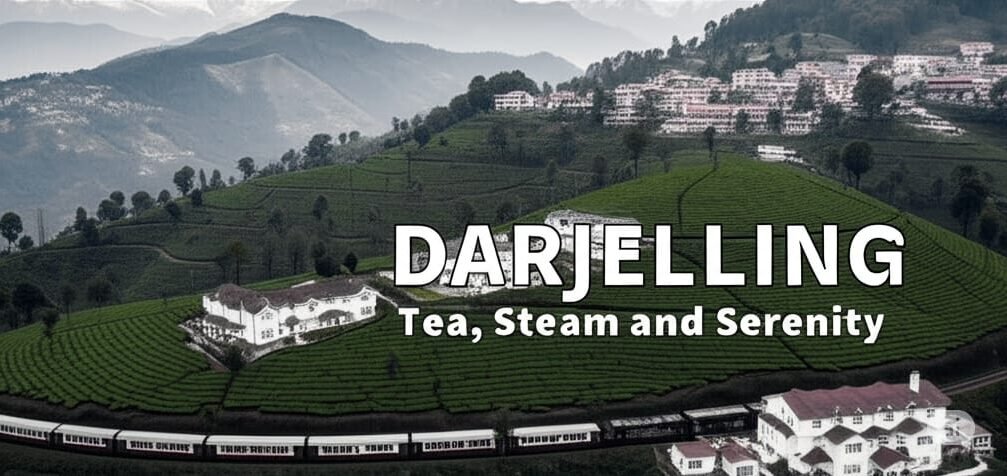I was standing beside a tiny railway track, unsure whether it was a road or a platform, when I heard the whistle of India’s oldest steam engine. A plume of white steam billowed into the misty air, and the world slowed down. That’s when I knew—I had arrived in Darjeeling. My journey from Delhi was a pilgrimage to this iconic hill station, a quest to experience its legendary toy train, its world-famous tea, and the elusive glimpse of the mighty Kanchenjunga.
For those planning to explore this “Queen of the Hills,” here’s a quick overview. The journey typically involves a flight to Bagdogra (Siliguri) followed by a scenic taxi ride up to Darjeeling. The absolute must-do experience is a ride on the Darjeeling Himalayan Railway (DHR), a UNESCO World Heritage Site. The best time for clear mountain views is from October to December. For tea lovers, a visit to estates like Happy Valley or Ringtong is essential. And for those seeking solitude, a short trip to the nearby forest hamlet of Lepcha Jagat is highly recommended.
Arrival: Where the Town Wraps Around You
Arriving in Darjeeling is a sensory immersion. The air is chilly, carrying the scent of damp earth and woodsmoke. The streets are a vibrant mix of Nepali, Bengali, and Tibetan voices. And everywhere, there is the feeling of being nestled in the clouds. Darjeeling doesn’t welcome you with open arms; it slowly, gently wraps itself around you in a blanket of mist and memory.
The Toy Train: A Ride Through Living History
The Darjeeling Himalayan Railway is the town’s beating heart. Built by the British between 1879 and 1881 primarily to transport tea, this engineering marvel operates on a narrow gauge of just 2 feet. Riding it feels like traveling back in time.
I booked the Darjeeling-Ghum roundtrip online via IRCTC. The journey in the vista-dome coach was surreal. The tiny steam engine, some over a century old, chugged along tracks laid so close to shops that you could almost touch the goods on display. Children ran alongside, waving with pure joy. The train makes a famous stop at the Batasia Loop, an ingenious spiral that allows it to navigate the steep gradient, offering a panoramic view of the town and, on a clear day, Kanchenjunga. We finally reached Ghum Station, which, at 7,407 ft, is the highest railway station in India. The sound of that steam whistle echoing through the hills is a sound I will never forget.
Tea, Steam, and a Taste of Heritage
You cannot talk about Darjeeling without talking about its tea. Introduced by the British in the 1800s, Darjeeling tea is globally prized for its unique floral aroma, or “muscatel” flavor. I visited a local tea estate where I walked through the gardens, learned about the difference between the first and second flush, and watched the intricate process of withering, rolling, and drying the leaves. Sipping a cup of authentic second flush Darjeeling tea while looking out at the gardens where it grew is a truly sublime experience. It’s no wonder that some rare varieties, like the Darjeeling Silver Tips Imperial, can fetch prices as high as ₹1.5 lakh per kilogram.
The Sacred View: A Six-Day Wait for Kanchenjunga
Every traveler in Darjeeling shares one common prayer: a clear view of the Kanchenjunga massif, the third highest peak in the world. For the first five days of my trip, the “Sleeping Buddha” formation remained hidden behind a thick veil of clouds. I woke up at 4 AM each day, hoping, waiting.
On the sixth morning, it happened. The clouds parted, and there it was—majestic, serene, and bathed in the golden light of dawn. The sight of that sacred peak silences you. It’s a moment of pure, unadulterated awe, a divine reward for your patience. It’s a powerful reminder that some of the most beautiful things in life cannot be planned; they can only be received with a grateful heart.
Lepcha Jagat: A Journey into Silence
Just 15 km from the bustle of Darjeeling lies Lepcha Jagat, a place that feels centuries apart in pace. I took a local taxi to this quiet forest hamlet. The world here is defined by towering pine trees, thick fog, and a profound, healing silence. I spent my time walking through the forest trails, where the only sound was the crunch of pine needles under my feet. It was here, in the quiet solitude of the forest, that I felt I could hear my own breath for the first time on the trip.
A Traveler’s Guide to Darjeeling
- Book the Toy Train in Advance: The joyride from Darjeeling to Ghum is very popular. Book your tickets online on the IRCTC website to avoid disappointment.
- Be Patient for the View: Kanchenjunga reveals itself on its own terms. The best chances are in the early mornings from October to December.
- Visit a Tea Estate: Happy Valley Tea Estate is easily accessible from town and offers guided tours and tea tasting sessions.
- Respect the Heritage and Nature: The DHR is over a century old; treat it with care. In forests like Lepcha Jagat, maintain the silence and do not litter.
- Support Local: Shop for tea from local vendors, eat at the small Nepali cafes, and appreciate the artisans to support the local economy.
A Final Reflection
Darjeeling isn’t just a destination; it’s a mood. It’s a feeling brewed slowly with fragrant tea, historic steam, patient waiting, and the quiet wisdom of the sky. It’s a place that teaches you that the most beautiful views are worth waiting for, and the most profound peace is often found in the simplest moments of silence.

Leave a Reply